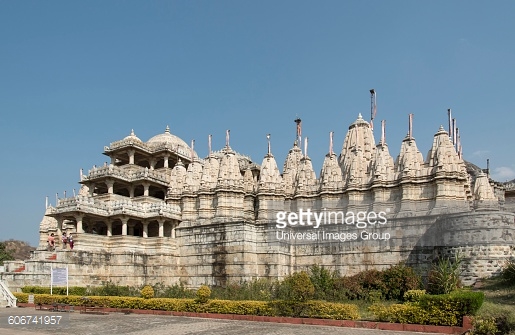Dilwara Jain Temples

The Dilwara Jain Temples of India are located about 2½ kilometres from Mount Abu, Rajasthan’s only hill station. Dilwara Jain Temples were built by Vastupal-Tejpal, a Jain laymen between the 11th and 13th centuries AD and are world famous for their stunning use of marble. The five legendary marble temples of Dilwara are a sacred pilgrimage place of the Jains. Some consider them to be one of the most beautiful Jain pilgrimage sites in the world. The marble temples have an opulent entranceway, the simplicity in architecture reflecting Jain values like honesty and frugality. The Dilwara Jain Temples are in the midst of a range of forested hills. A high wall shrouds the temple complex.
Although the Jains built some beautiful temples at other places in Rajasthan, some believe that none come close to these in terms of architectural perfection. The ornamental detail spreading over the minutely carved ceilings, doorways, pillars and panels is simply marvellous.
Facilities are available for bathing, which is mandatory before puja is performed for the idols. These facilities use passive solar power to heat up the water for bathing and other things. Guided tour hours for tourists are posted outside the temple.
There are five temples in all, each with its own unique identity. Each is named after the small village in which it is located. These are:
Vimal Vasahi, dedicated to the first Jain Tirthankara, Rishabha.
Luna Vasahi, dedicated to the 22nd Jain Tirthankara, Neminatha.
Pithalhar, dedicated to the first Jain Tirthankar, Rishabha.
Parshvanath, dedicated to the 23rd Jain Tirthankara, Parshvanatha.
Mahavir Swami, dedicated to the last Jain Tirthankara, Mahavira.
The most famous of these are the Vimal Vasahi and Luna Vasahi temples.
Vimal Vasahi Temple

This temple carved entirely out of white marble was built in 1031 A.D. by Vimal Shah, a minister of Bhimdev I, the Chalukya King (Solanki Maharaja) of Gujarat. The temple is dedicated to Lord Rishabha. The temple stands in an open courtyard surrounded by a corridor, which has numerous cells containing smaller idols of the tirthankaras. The richly carved corridors, pillars, arches, and ‘mandaps ‘ or porticoes of the temple are simply amazing. The ceilings feature engraved designs of lotus-buds, petals, flowers and scenes from Jain mythology.
The Rang mandap is a grand hall supported by 12 decorated pillars and nicely carved out arches with a breathtaking central dome. On the pillars are carved female figurines playing musical instruments and 16 Vidhyadevis, or the goddesses of knowledge, each one holding her own symbol.
The Navchowki is a collection of nine rectangular ceilings, each one containing beautiful carvings of different designs supported on ornate pillars. The Gudh mandap is a simple hall once you step inside its heavily decorated doorway. Installed here is the idol of Adi Nath or Lord Rishabdev, as he is also known. The mandap is meant for Aarti to the deity. The Hastishala (Elephant Cell) was constructed by Prithvipal, a descendant of Vimal Shah in 1147-49 and features a row of elephants in sculpture.
Luna Vasahi

The Luna Vashi temple is dedicated to Lord Neminath. This magnificent temple was built in 1230 by two Porwad brothers – Vastupal and Tejpal – both ministers of a Virdhaval, the Vaghela ruler of Gujarat. The temple built in memory of their late brother Luna was designed after the Vimal Vashi temple. The main hall or Rang mandap features a central dome from which hangs a big ornamental pendent featuring elaborate carving. Arranged in a circular band are 72 figures of Tirthankars in sitting posture and just below this band are 360 small figures of Jain monks in another circular band. The Hathishala or elephant cell features 10 beautiful marble elephants neatly polished and realistically modelled.
The Navchowki features some of the most magnificent and delicate marble stone cutting work of the temple. Each of the nine ceilings here seems to exceed the others in beauty and grace. The Gudh mandap features a black marble idol of the 22nd tirthankar Neminatha. The Kirthi Stambha is a big black stone pillar that stands on the left side of the temple. The pillar was constructed by Maharana Kumbha of Meawr. The remaining three temples of Dilwara are smaller but just as elegant as the other two.
Source : Wikipedia
https://www.youtube.com/watch?v=qlZL2uBz1HA
Reviews
Cool Tips
The temple is open for non-Jain visitors from noon to 6 pm (Jain visitors can visit from sunrise to sunset). Photography is not allowed inside the temple premises and bags are searched to prevent cameras being taken in. as at other Jain temples, all articles of leather have to be left at the entrance (where you pay a few rupees when collecting them). You can stroll out to Dilwara from the town in less than an hour, or can get a shared taxi from opposite of Madras Cafe, in the center of the town.
Entry fee : Free



Rate this article